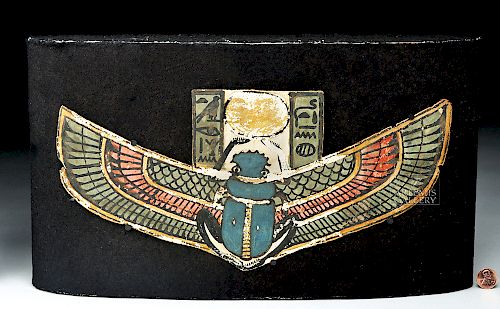Egyptian Cartonnage Section w/ Scarab - ex-Bonhams
Lot 62
About Seller
Artemis Gallery
686 S Taylor Ave, Ste 106
Louisville, CO 80027
United States
Selling antiquities, ancient and ethnographic art online since 1993, Artemis Gallery specializes in Classical Antiquities (Egyptian, Greek, Roman, Near Eastern), Asian, Pre-Columbian, African / Tribal / Oceanographic art. Our extensive inventory includes pottery, stone, metal, wood, glass and textil...Read more
Categories
Estimate:
$1,500 - $2,000
Absentee vs Live bid
Two ways to bid:
- Leave a max absentee bid and the platform will bid on your behalf up to your maximum bid during the live auction.
- Bid live during the auction and your bids will be submitted real-time to the auctioneer.
Bid Increments
| Price | Bid Increment |
|---|---|
| $0 | $25 |
| $300 | $50 |
| $1,000 | $100 |
| $2,000 | $250 |
| $5,000 | $500 |
| $10,000 | $1,000 |
| $20,000 | $2,500 |
| $50,000 | $5,000 |
| $100,000 | $10,000 |
| $200,000 | $20,000 |
About Auction
By Artemis Gallery
May 10, 2018
Set Reminder
2018-05-10 10:00:00
2018-05-10 10:00:00
America/New_York
Bidsquare
Bidsquare : Fine Ethnographic / Asian / Ancient Art
https://www.bidsquare.com/auctions/artemis-gallery/fine-ethnographic-asian-ancient-art-3213
Featuring antiquities from around the world including Pre-Columbian, Tribal, Classical, Asian, so much more! Artemis Gallery info@artemisgallery.com
Featuring antiquities from around the world including Pre-Columbian, Tribal, Classical, Asian, so much more! Artemis Gallery info@artemisgallery.com
- Lot Description
Egypt, Late Dynastic to Ptolemaic periods, ca. 664 to 30 BCE. A beautiful section of gessoed cartonnage - layers of linen or papyrus covered with plaster, formed into a panel to line the inside of a sarcophagus or used as mummy decoration. This section is comprised of a stylized azure-hued scarab beetle with thin legs and large wing panels, with a pair of enormous wings - suggestive of the winged Isis - projecting laterally from its sides. The wings are each decorated with three rows of colorful feathers in hues of ruby and dark turquoise, with a thin gold-hued border separating each section as well as the peripheries. The front legs of the scarab hold aloft a yellow-painted sun disk, with two vertical columns of hieroglyphics on either side - read right to left, top to bottom. This section would have been placed near the abdomen of the mummified individual. Mounted on a felt-lined wooden panel. Size (cartonnage): 13.5" W x 6.25" H (34.3 cm x 15.9 cm); size (mount): 15.75" W x 9" H (40 cm x 22.9 cm).
By the time of the Late Dynastic period, the elaborate funerary rituals and furniture of the Egyptian grave had become an industry, mass produced, and given to, for the first time, the non-elite. While on the one hand, this signaled a decline in these religious practices and a simplification of motifs and artwork, it also represented a democratization of death, opening up access to privileged religious and afterlife-ensuring rituals to many more members of the society.
Provenance: private Davis collection, Houston, Texas, USA; ex-Bonham's London Antiquities Auction, 8 May, 2013, lot 317; ex-private M.D. collection, Belgium, formed before 1960
All items legal to buy/sell under U.S. Statute covering cultural patrimony Code 2600, CHAPTER 14, and are guaranteed to be as described or your money back.
A Certificate of Authenticity will accompany all winning bids.
We ship worldwide and handle all shipping in-house for your convenience.
#132785Repair to tip of left wing. Repair to portion of right wing with some restoration and overpainting along break line. Surface wear commensurate with age, small losses around peripheries, fading and losses to areas of interior pigmentation, with some surface roughness, otherwise very good.Condition
- Shipping Info
-
All shipping is handled in-house for your convenience. Your invoice from Artemis Gallery will include shipping calculation instructions. If in doubt, please inquire BEFORE bidding for estimated shipping costs for individual items.
-
- Buyer's Premium



 EUR
EUR CAD
CAD AUD
AUD GBP
GBP MXN
MXN HKD
HKD CNY
CNY MYR
MYR SEK
SEK SGD
SGD CHF
CHF THB
THB














